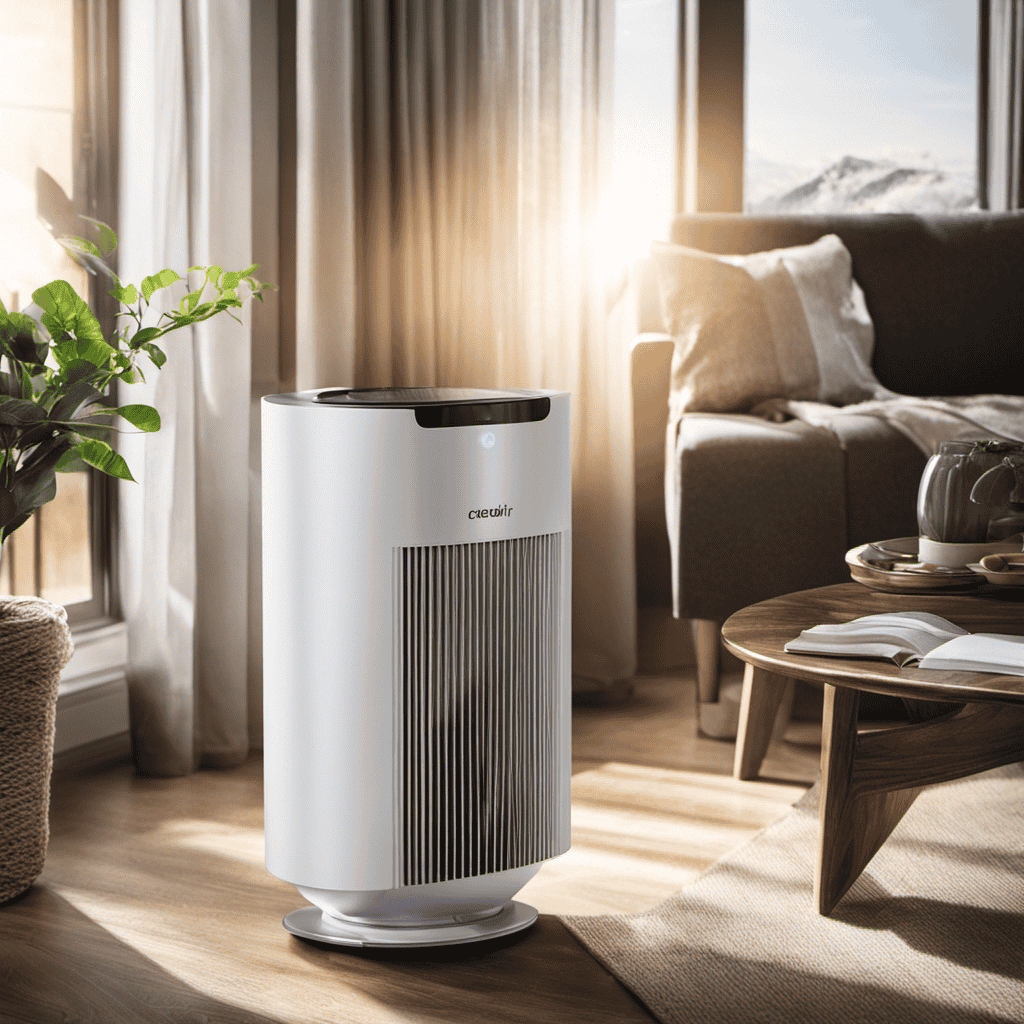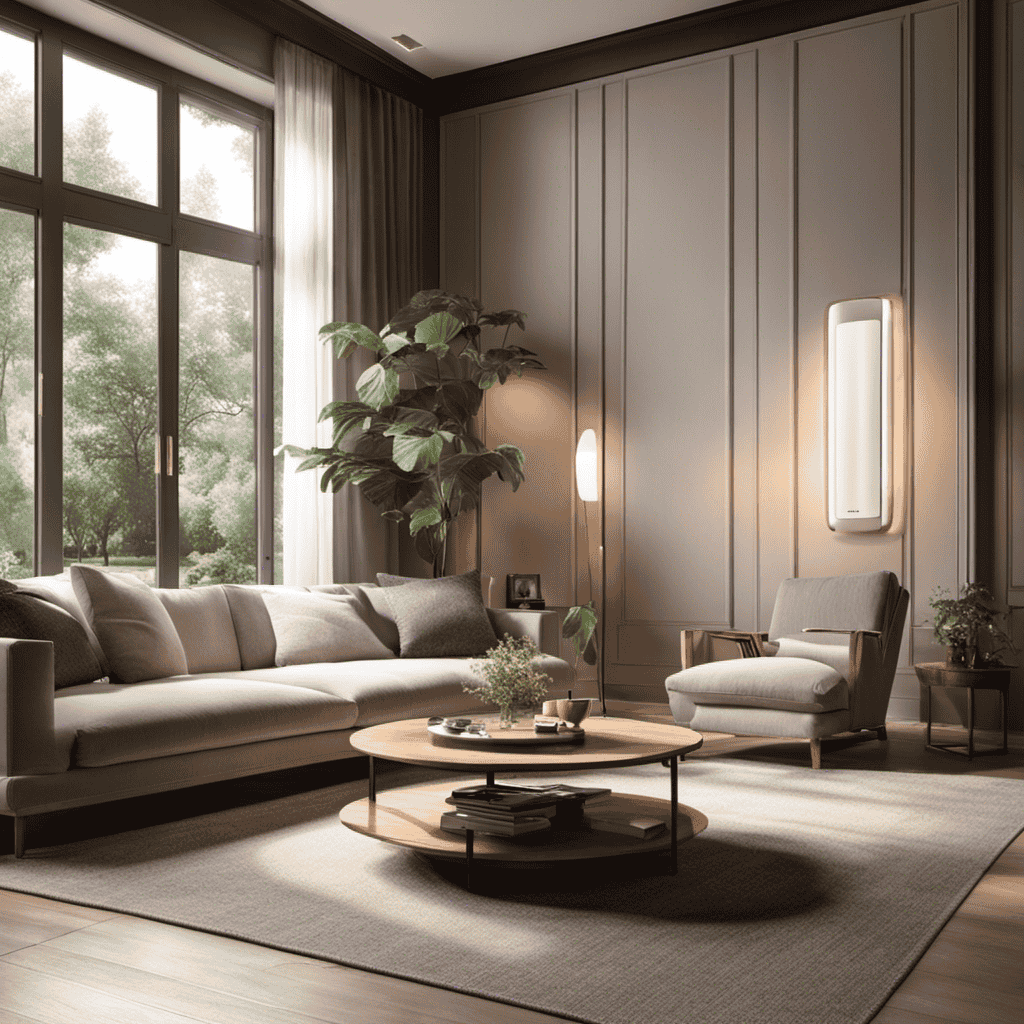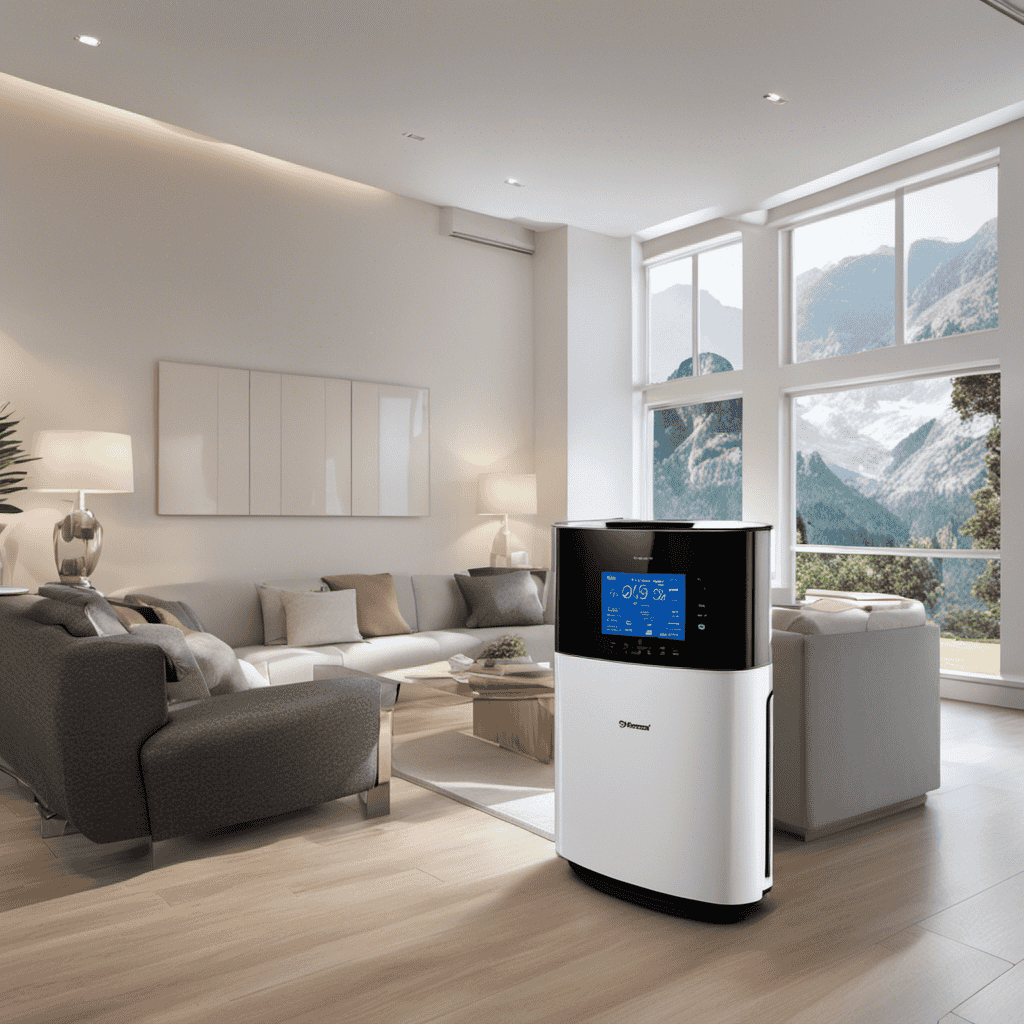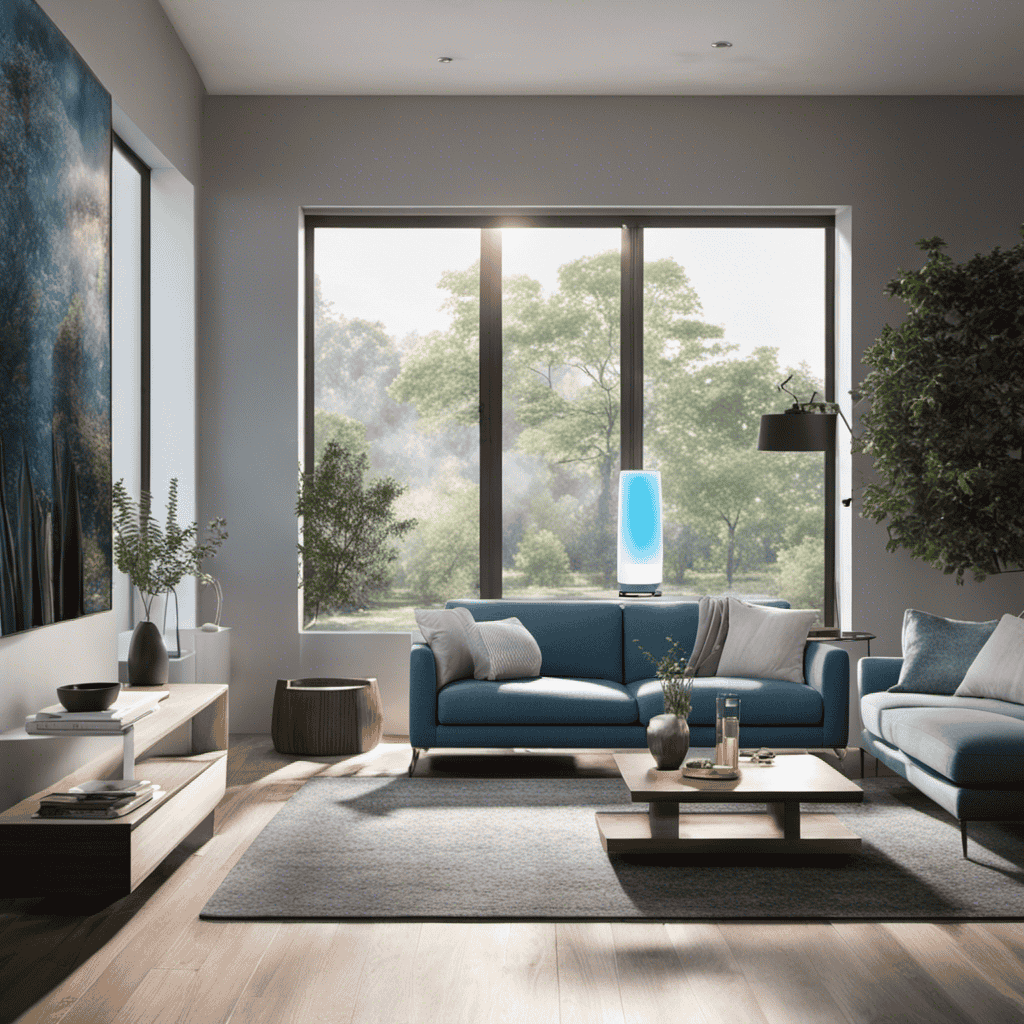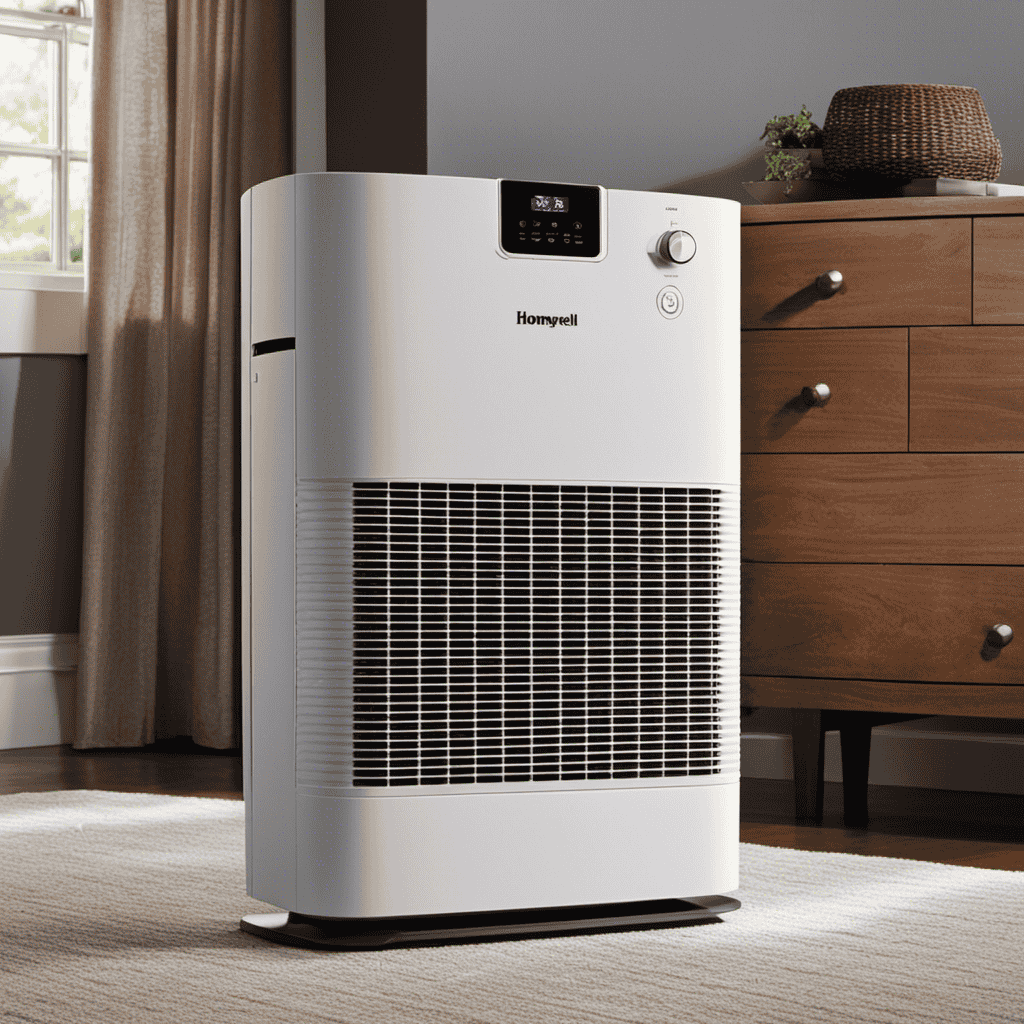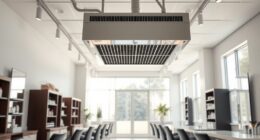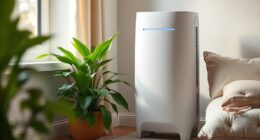They say that the devil is in the details, and when it comes to air purifiers, placement is no exception. As someone who has spent countless hours researching the topic, I can confidently say that where you place your air purifier can greatly impact its effectiveness.
In this article, we will delve into the importance of proper placement, explore the ideal locations for placement, and discuss common mistakes to avoid.
So, let’s dive in and discover if it really does matter where you place your air purifier.
Key Takeaways
- Proper placement directly affects air purifier performance and ability to clean the air.
- Placing the air purifier in high-traffic areas can significantly improve indoor air quality.
- Placing the air purifier near potential sources of pollutants enhances its efficiency.
- Optimal placement helps reduce allergens in the air, such as pollen, dust mites, and pet dander.
Importance of Placement
To maximize the effectiveness of your air purifier, make sure you’re placing it in the right spot. The importance of proper placement cannot be overstated, as it directly affects the performance of the device and its ability to clean the air in your home. Research has shown that air purifiers placed in high-traffic areas, such as living rooms or bedrooms, can significantly improve indoor air quality. Additionally, placing the air purifier near potential sources of pollutants, such as pet areas or cooking spaces, can further enhance its efficiency.
Maintenance is also a crucial aspect to consider when it comes to air purifiers. Regularly cleaning and replacing the filters is essential to ensure optimal performance. Clogged filters can hinder the purifier’s ability to capture airborne particles effectively, reducing its overall effectiveness. By following the manufacturer’s guidelines for maintenance, you can ensure that your air purifier continues to operate at its best.
Furthermore, when it comes to allergies, proper placement of an air purifier can have a significant impact. Allergens such as dust mites, pollen, and pet dander can trigger allergic reactions and worsen symptoms. Placing the air purifier in the room where you spend the most time, such as the bedroom, can help reduce exposure to these allergens and provide relief from allergy symptoms.
Ideal Placement Locations
The ideal locations for placing an air purifier are in bedrooms, living rooms, and home offices. When considering where to place your air purifier, it’s important to think about both functionality and aesthetics. You want to ensure that the purifier is effectively removing pollutants from the air while also blending seamlessly into your living space.
To help you determine the best placement for your air purifier, consider the following table:
| Location | Pros | Cons |
|---|---|---|
| Bedroom | Promotes better sleep and reduces allergens | May create noise disturbance |
| Living Room | Improves air quality in the common area | Can be an obstruction in the room |
| Home Office | Enhances productivity and reduces dust | May take up valuable desk space |
When placing an air purifier in a room, it’s important to avoid corners. Placing the purifier in the center of the room allows for better air circulation and ensures that pollutants are evenly filtered. Additionally, consider the noise reduction capabilities of the purifier. Placing it further away from areas where you spend a lot of time can help minimize any potential disturbance.
In the next section, we will explore the importance of avoiding obstructions when placing an air purifier.
Avoiding Obstructions
When considering where to put your air purifier, it’s crucial to avoid obstructing its airflow in order to maximize its effectiveness. Obstructions can significantly impact the air flow of your purifier, reducing its ability to properly filter and clean the air in your space. To ensure optimal performance, keep the following in mind:
-
Furniture Placement: Avoid placing your air purifier behind or underneath furniture, such as couches or bookshelves. These objects can block the intake and outlet vents, restricting the flow of air and hindering the purifier’s ability to circulate and filter the air effectively.
-
Curtains and Drapes: Be mindful of hanging curtains or drapes near your air purifier. These materials can obstruct the airflow and prevent the purifier from pulling in the contaminated air, resulting in reduced filtration efficiency.
-
Wall Obstructions: Ensure that your air purifier is not placed too close to walls or corners. This can disrupt the air flow pattern and cause stagnant air pockets, limiting the purifier’s ability to effectively clean the entire room.
Considering Air Circulation
When it comes to maximizing the effectiveness of an air purifier, optimal placement plays a crucial role. Understanding the impact of air circulation on the device’s performance is essential for achieving the desired results.
Additionally, considering the size of the room is important as it determines the purifier’s ability to clean the air effectively and efficiently.
Optimal Placement for Effectiveness
For best results, it’s important to consider where you should place an air purifier. Here are three key factors to consider when determining optimal placement:
-
Proximity to the source of air pollutants: Place the air purifier closer to the source of allergens or pollutants to maximize its effectiveness in reducing their impact on allergies. For example, if you suffer from pet allergies, placing the purifier near your pet’s resting area would be beneficial.
-
Airflow and circulation: Ensure that the air purifier is placed in an area with good airflow and circulation. This will allow the purifier to effectively capture and filter the air, reducing allergens and pollutants. Avoid placing it in corners or behind furniture that may obstruct airflow.
-
Noise level: Consider the noise level of the air purifier when choosing its placement. If you are sensitive to noise while sleeping or working, avoid placing it in your bedroom or office space. Opt for a location where the noise from the purifier will not disturb your activities or relaxation.
Impact on Air Quality
In the previous section, we discussed the optimal placement of an air purifier to maximize its effectiveness. Now, let’s explore the impact of clean air on our health and the benefits it provides.
Breathing clean air is essential for maintaining good health. Air pollution can have detrimental effects on our respiratory system, leading to various respiratory conditions such as asthma, bronchitis, and even lung cancer. By using an air purifier, we can filter out harmful particles and pollutants, improving the air quality in our homes and reducing the risk of these health issues.
Clean air also offers several benefits beyond respiratory health. It can enhance our overall well-being by promoting better sleep, reducing allergies, and boosting our immune system. Additionally, clean air can improve cognitive function and productivity, allowing us to think and perform better.
Considering the positive impact on our health and well-being, it is crucial to carefully consider the placement of an air purifier in our living spaces. Now, let’s delve into the considerations for room size to ensure optimal results.
Considerations for Room Size
The size of the room affects where you should position the air purifier. When considering the room layout, it is important to place the air purifier in an area that allows for optimal air circulation. Here are three key considerations to keep in mind:
-
Placement near the source of pollutants: If there are specific areas in the room where pollutants are more concentrated, such as near a pet’s bedding or a smoking area, it is recommended to position the air purifier closer to these sources for better air purification.
-
Central location for even air distribution: Placing the air purifier in the middle of the room allows for better airflow and distribution of purified air throughout the space. This ensures that the entire room benefits from the air purifier’s filtration capabilities.
-
Noise level: Consider placing the air purifier away from areas where you spend most of your time, such as near your bed or workspace, to reduce any potential disturbance caused by the noise generated by the air purifier’s operation.
Best Rooms to Place an Air Purifier
When it comes to maximizing the effectiveness of an air purifier, optimal placement is crucial. Research has shown that placing the device in high-pollution areas can significantly improve its performance.
Optimal Placement for Effectiveness
To maximize the effectiveness of your air purifier, you should consider placing it in a central location within the room. This placement allows for better air circulation and ensures that the purifier can effectively capture and remove airborne pollutants. Here are three reasons why optimal placement is important:
-
Impact on Allergies: Placing the air purifier in a central location helps to reduce allergens in the air, such as pollen, dust mites, and pet dander. By continuously filtering the air in the room, the purifier can trap these allergens, providing relief for allergy sufferers.
-
Impact on Sleep Quality: Poor air quality can disrupt sleep and lead to restless nights. Placing the air purifier near the bed can help improve sleep quality by removing pollutants and ensuring cleaner air to breathe while you sleep.
-
Overall Effectiveness: When positioned centrally, the air purifier can draw in air from all corners of the room, maximizing its efficiency in capturing and removing pollutants. This ensures that the air you breathe is clean and free from harmful particles, promoting better health and well-being.
Targeting High-Pollution Areas
For optimal results, I highly recommend targeting the areas in your home with the highest pollution levels. These high pollution hotspots can include spaces near the kitchen, where cooking activities release harmful particles, or near the main entrance, where outdoor pollutants can easily enter. By strategically placing your air purifier in these areas, you can maximize its effectiveness in removing pollutants and improving indoor air quality.
Targeting high-pollution areas offers several benefits. Firstly, it allows you to focus the air purifier’s purification efforts where they are most needed, ensuring that the air you breathe in those spaces is clean and healthy. Secondly, it can help reduce the overall workload of the purifier, as it doesn’t have to clean the entire house at once. This can result in increased efficiency and longevity of the device. Lastly, targeting high-pollution areas can lead to cost savings, as you can potentially use smaller, more energy-efficient purifiers in specific locations rather than larger devices for the entire house.
Impact of Placement on Performance
The placement of an air purifier can affect its performance. It is important to consider the ideal placement height and the impact it can have on allergies. Here are three key points to keep in mind when positioning your air purifier:
-
Height matters: Placing the air purifier at the ideal height can maximize its effectiveness. As allergens and pollutants tend to be heavier than air, positioning the purifier at a height of about 2 to 6 feet from the ground allows it to capture these particles more efficiently. This level ensures that the purifier can effectively filter the air at breathing height.
-
Adequate airflow: It is crucial to avoid obstructing the airflow around the air purifier. Placing it too close to walls or furniture can restrict the circulation of air and reduce its overall performance. Keep a distance of at least a foot from any obstruction to allow the purifier to draw in air from all directions and deliver clean, filtered air throughout the room.
-
Strategic placement: Consider the layout of your space and the areas where you spend the most time. Placing the air purifier in the room where you sleep or spend the majority of your time can help alleviate allergies by continuously cleaning the air in those specific areas.
Proper placement of an air purifier can greatly enhance its ability to reduce allergens and improve indoor air quality. However, there are common placement mistakes that should be avoided to ensure optimal performance.
Common Placement Mistakes
Avoid making the mistake of obstructing the airflow around your air purifier by placing it too close to walls or furniture. Proper placement plays a crucial role in maximizing the effectiveness of your air purifier and ensuring clean and healthy air in your home. Many people make common mistakes when it comes to placing their air purifiers, which can hinder their performance and compromise the benefits they offer.
One common mistake is placing the air purifier in a corner or against a wall. This restricts the airflow and prevents the purifier from effectively circulating the air in the room. Additionally, placing the purifier too close to furniture can obstruct the intake and exhaust vents, reducing its efficiency.
To emphasize the importance of proper placement, consider the following table:
| Common Placement Mistakes | Benefits of Proper Placement |
|---|---|
| Placing purifier in a corner or against a wall | Allows for optimal airflow |
| Placing purifier too close to furniture | Prevents obstruction of vents |
Tips for Optimal Air Purifier Placement
Properly positioning your air purifier can greatly enhance its performance and effectiveness. Here are three tips to maximize efficiency and improve indoor air quality:
-
Consider the size of the room: Place your air purifier in a room that you spend the most time in, such as the bedroom or living room. The size of the room plays a crucial role in determining the effectiveness of the purifier. Make sure to choose an air purifier that is suitable for the dimensions of the room. A purifier that is too small may not be able to effectively clean the air, while one that is too large may use unnecessary energy.
-
Avoid blocking airflow: To ensure optimal performance, keep your air purifier away from obstructions that could hinder airflow. Avoid placing it behind furniture or in cramped corners. Instead, position the purifier in an open area where it can circulate air freely. This will allow it to capture and remove airborne particles more effectively, improving the overall air quality in the room.
-
Place it at the right height: The height at which you position your air purifier can also impact its efficiency. Ideally, it should be placed at a level where it can effectively capture pollutants. For example, if you are concerned about pet dander or allergens, placing the purifier at a lower height can help it capture these particles. On the other hand, if you are concerned about smoke or gases, positioning it at a higher level can be more effective.
Can the Placement of an Air Purifier Affect Its Noise Level?
When considering quiet air purifier options, placement is key in reducing noise levels. Placing the air purifier on a stable surface away from walls and furniture can minimize vibrations and sound. Keeping it in a central location can also help distribute clean air more efficiently while keeping noise to a minimum.
Frequently Asked Questions
Can I Place My Air Purifier in a Small, Enclosed Space Like a Closet or Pantry?
Yes, you can place an air purifier in a small, enclosed space like a closet or pantry. However, it is important to consider the air purifier maintenance and the benefits of using an air purifier in a small space.
Placing the air purifier in such a space can help to improve the air quality by removing pollutants and allergens. Regular maintenance, such as cleaning and replacing filters, is essential to ensure optimal performance.
Is It Necessary to Place an Air Purifier Near a Window for Better Air Circulation?
Placing an air purifier near a window is often recommended for better air circulation. However, it’s important to consider the effectiveness of air purifiers in reducing outdoor pollutants.
While proximity to a window can help in drawing in fresh air, it’s not the only factor. The impact of air purifier placement on energy consumption should also be taken into account.
Ultimately, finding a balance between air circulation, pollutant reduction, and energy efficiency is key.
Can I Place an Air Purifier on the Floor or Does It Need to Be Elevated?
When deciding where to place an air purifier, one consideration is whether to put it on the floor or elevate it.
Placing it on the floor can be effective in capturing airborne particles closer to the ground.
However, elevating the air purifier can provide better circulation and distribution of clean air throughout the room.
Should I Avoid Placing the Air Purifier Near Electronics or Appliances That Generate Heat?
Avoid placing the air purifier near electronics or appliances that generate heat. Heat sources can interfere with the air purifier’s performance and potentially cause damage.
It is necessary to place the air purifier near a window for better air circulation as it allows for the intake of fresh air.
Can I Place an Air Purifier in My Bedroom While I Sleep, or Is It Better to Have It Running in a Different Room?
I find it important to consider where to place an air purifier, especially when it comes to using it in my bedroom while I sleep.
While it may be tempting to have it running in the same room for maximum effectiveness, there are benefits to using it in the living room during the day. This allows for better circulation of clean air throughout the house.
Additionally, placing the air purifier strategically can help minimize energy consumption.
Conclusion
In conclusion, the placement of an air purifier is crucial for its performance and effectiveness. By placing it in an ideal location, such as near sources of pollution or in frequently used rooms, you can maximize its ability to clean the air. Avoiding obstructions and considering air circulation are important factors to ensure optimal purification.
Remember, a well-placed air purifier can be your secret weapon against indoor air pollution. So, don’t underestimate its impact. Take control of your air quality and breathe in the freshness!
